Switzerland › Railway lines
In memory of an ambitious enterprise
Ferrovia Mesolcinese (Castione-Arbedo - Cama)
1000 mm
Castione-Arbedo - Cama
Castione-Arbedo - Cama
section Bellinzona - Lugano
Giubiasco - Locarno
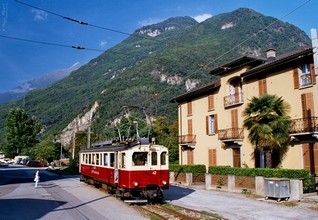

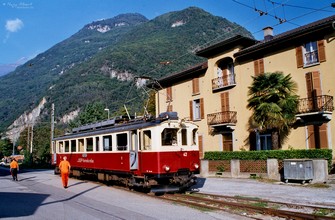

On a weekend in October 2005 the motor car ABe 4/4 42 commuted on the line. The vehicle, which was once in service of Appenzeller Bahn stands here at Castione-Arbedo station (Canton Ticino).
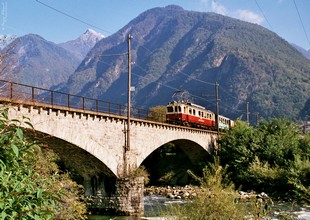

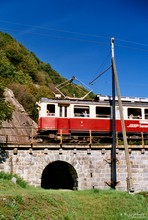

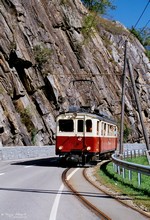

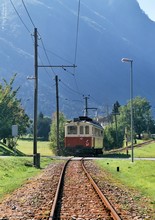

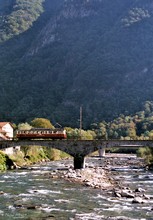

Already in Graubünden, around Roveredo, the train runs on the bridges Moesa II and III. On the Moesa I bridge near Bellinzona, the railway traffic was closed as early as 1972.
It would have been a great achievement to connect the capitals of Ticino and Graubünden by building a railway over the San Bernardino Pass. The 31,3 km long line from Bellinzona to Mesocco was finished in 1907 – electrified with 1500 V DC, with 60 ‰ maximum inclination and 80 m smallest radius. Its main task was to link the Valle Mesolcina (valley in Graubünden canton at the border of Ticino, south from the main chain of the Alps) to the traffic network. But the argument that the line's location would facilitate the construction of a new cross-alpine connection between Chur and Bellinzona, played a significant role in the development of this narrow-gauge railway. The Albula Railway, piercing through the watershed using a 6 km long tunnel, was finished in 1903, while the construction of the Bernina Line, which crosses the pass at 2253 m above sea level, started in 1906 – a similar enterprise would not have been unlikely in the south-western corner of Graubünden either. Still, the realization of the new link was not immediately begun, and the First World War with the subsequent economic crisis made it impossible to find the necessary financial resources.
The opening of the cantonal road for car traffic through the San Bernardino Pass in 1933 made its last lunge at the ambitious plans. The appearance of this new competition started the decline in the traffic volume and financial position of the railway company (Società Ferrovia elettrica Bellinzona-Mesocco, short BM).
Along with the Arosa Line and the Bernina Railway, BM could be saved only by a merger with Rhaetian Railway in 1942. The modernization carried out by RhB could not stop the decline in passenger numbers, and the construction of the motorway A13 made the line’s future doubtful. At the end of the 60s the planned procurement of rolling stock was cancelled, instead the railway’s operation was maintained with old motor cars rented from Appenzeller Bahn. Passenger traffic was discontinued in 1972, but freight transport remained intact. The line had connection to the standard-gauge network in Castione-Arbedo, and the section leading from there to Bellinzona was used only for passenger transport: this was no longer needed and got demolished soon. In a storm in 1978, the upper section suffered such severe damages that traffic between Cama and Mesocco had to be stopped completely, and the tracks were demolished.
Apart from RhB’s freight trains, an association named Società Esercizio Ferroviario Turistico (SEFT) ran touristic trains on the remaining section between Castione-Arbedo and Cama from 1995 on. When eventually in 2003 the freight traffic was discontinued as well, RhB handed over the that time 13 km long line to SEFT. The association was able to maintain the museum operation until 2013, under the name Ferrovia Mesolcinese (FM). That year the infrastructure concession was dissolved in favor of the planned reconstruction of the town center of Roveredo. The passenger transport concession of SEFT was not prolonged either.
Until now, the railway line, which once started with great hopes, got widely demolished.
Please, sign in to post a new comment!

